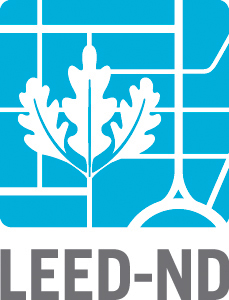Reminder: A LEED for Homes development located in a LEED ND project area will receive full points for the “Locations and Linkages (LL)” category (learn more). This also pertains to the new Sustainable Communities regional planning grant NOFA announced June 24.
Federal agency encourages smart growth, location efficiency and green communities
The federal government took a major step toward its mission to advance sustainability practices among buildings and communities when U.S. Department of Housing and Urban Development (HUD) Secretary Shaun Donovan announced that LEED® for Neighborhood Development will be used to score the location efficiency of grant applications. HUD will apply this criteria to grant submissions to the upcoming Sustainable Communities Planning Grants and others, totaling $3.25 billion in available grant funds.
“Using the ‘LEED-ND’ green neighborhood rating system…it’s time that federal dollars stopped encouraging sprawl and started lowering the barriers to the kind of sustainable development our country needs and our communities want,” said Secretary Donovan.
LEED for Neighborhood Development, which launched in April as the benchmark for healthy green communities, integrates green building into community development, helping to reduce sprawl, increase transportation choices, decrease automobile dependence, encourage healthy living and protect threatened species.
“The federal government has been a pioneer in the green building movement – not only seeking high-performance from its own buildings, but through incentives and grants that encourage environmental stewardship,” said Rick Fedrizzi, President, CEO and Founding Chair, U.S. Green Building Council. “HUD has been a powerful voice in encouraging and creating sustainable communities in which residents will have access to alternative transportation, jobs, and an increased quality of life. LEED for Neighborhood Development serves as an important tool to help evaluate and fund these new communities.”
The imperative for sustainable communities is made even more urgent in this economy as housing and transportation are the two biggest expenses for families, constituting for more than 50% of the average American household budget. Green communities, as defined by HUD, are “economically competitive, healthy and opportunity-rich” and provide an important component of community development to local, state and national economies.
Secretary Donovan stated the “housing and economic crisis has reaffirmed the need for federal leadership in this area,” drawing the correlation between foreclosure rates and access to transportation, good schools and economic opportunity.
LEED for Neighborhood Development, which was created in partnership with the Natural Resources Defense Council (NRDC) and the Congress for the New Urbanism (CNU), acknowledges the link between transit-oriented development and proximity to services, amenities and jobs to human health benefits and economic capital, an important correlation confirmed in numerous studies and advocated for by the Environmental Protection Agency and the Centers for Disease Control and Prevention. Connectivity to neighboring communities and their amenities and services through transit corridors and a well-connected street network, greatly benefits the citizens, businesses and local economy of a new neighborhood development, the surrounding community, and ultimately the region.
“…We live in a changing world where cities, suburbs and the rural areas that surround them share an economic future. Metropolitan regions are the engines of our economy…people are voting with their feet more and more — in search of walkable neighborhoods with transportation options,” said Secretary Donovan.
To read Secretary Donovan’s complete remarks, click here and to learn more about LEED for Neighborhood Development, visit www.usgbc.org/leed/nd.
Adapted from a USGBC Press Release.

